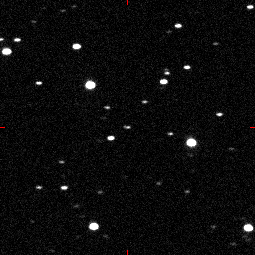
2004 FH is a micro-asteroid and near-Earth object of the Aten group, approximately 30 meters in diameter, that passed just 43,000 km (27,000 mi) above the Earth's surface on 18 March 2004, at 22:08 UTC. It was the 11th closest approach to Earth recorded as of 21 November 2008. The asteroid was first observed on 16 March 2004, by astronomers of the Lincoln Near-Earth Asteroid Research at the Lincoln Laboratory's Experimental Test Site near Socorro, New Mexico.
(6491) 1991 OA is a highly eccentric, stony asteroid, classified as near-Earth object and potentially hazardous asteroid, approximately half a kilometer in diameter. It was discovered on 16 July 1991, by American astronomer Henry E. Holt at the U.S. Palomar Observatory in California.
(467336) 2002 LT38, is a sub-kilometer asteroid and suspected tumbler, classified as a near-Earth object and potentially hazardous asteroid of the Aten group, approximately 240 meters (790 ft) in diameter. It was discovered on 12 June 2002, by astronomers of the Lincoln Near-Earth Asteroid Research at the Lincoln Laboratory's Experimental Test Site near Socorro, New Mexico, in the United States.
(416151) 2002 RQ25 is a carbonaceous asteroid of the Apollo group, classified as near-Earth object and potentially hazardous asteroid, approximately 0.2 kilometers in diameter. It was discovered on 3 September 2002, by the Campo Imperatore Near-Earth Object Survey (CINEOS) at the Italian Campo Imperatore Observatory, located in the Abruzzo region, east of Rome.
(471240) 2011 BT15, provisional designation 2011 BT15, is a stony, sub-kilometer sized asteroid and fast rotator, classified as a near-Earth object and potentially hazardous asteroid of the Apollo group. It had been one of the objects with the highest impact threat on the Palermo Technical Impact Hazard Scale.
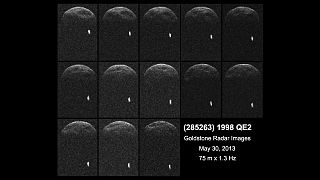
(285263) 1998 QE2, provisional designation 1998 QE2, is a dark asteroid and synchronous binary system, classified as near-Earth object and potentially hazardous asteroid of the Amor group, approximately 3 kilometers in diameter. It was discovered on 19 August 1998, by astronomers of the LINEAR program at Lincoln Laboratory's Experimental Test Site near Socorro, New Mexico, in the United States. Its sub-kilometer minor-planet moon was discovered by radar on 30 May 2013.
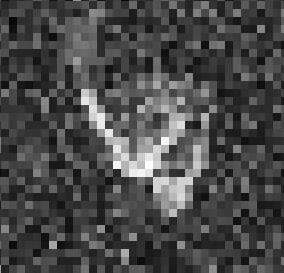
(192642) 1999 RD32, provisional designation: 1999 RD32, is an asteroid and suspected contact binary on an eccentric orbit, classified as a large near-Earth object and potentially hazardous asteroid of the Apollo group, approximately 5 kilometers (3 miles) in diameter. It was discovered on 8 September 1999, at a magnitude of 18, by astronomers of the LINEAR program using its 1-meter telescope at the Lincoln Laboratory's Experimental Test Site near Socorro, New Mexico, United States. The asteroid is likely of carbonaceous composition and has a rotation period of 17.08 hours.

2012 TC4 is a tumbling micro-asteroid classified as a bright near-Earth object of the Apollo group, approximately 10 meters (30 feet) in diameter. It was first observed by Pan-STARRS at Haleakala Observatory on the Hawaiian island of Maui, in the United States. As of 1 October 2017, it had a small Earth minimum orbital intersection distance of 0.000149 AU (22,300 km). On 12 October 2017, it passed Earth at 0.00033524 AU (50,151 km). The asteroid was removed from the Sentry Risk Table on 16 October 2017 and with a 5-year observation arc has a well-known orbit. For example, on the previously risk-listed date of 12 October 2022, it is now known that the asteroid will be more than 3 AU (450 million km) from Earth.
2001 AV43 is a very small, monolithic asteroid and fast rotator, classified as a near-Earth object of the Apollo group, approximately 30 meters (98 feet) in diameter. It was first observed on 5 January 2001, by astronomers of the LINEAR program at Lincoln Laboratory's Experimental Test Site near Socorro, New Mexico, in the United States. The presumed S-type asteroid has a rotation period of only 10 minutes. It has an exceptionally low MOID of 0.66 lunar distance (LD) and will approach Earth at 0.81 LD on 11 November 2029.
2015 HM10 is an irregular shaped asteroid and sub-kilometer near-Earth object that passed near the Earth on 7 July 2015, at a distance of 442,000 kilometers or 1.15 lunar distances.
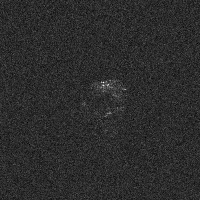
(436724) 2011 UW158, provisionally known as 2011 UW158, is a stony, walnut-shaped asteroid and fast rotator, classified as near-Earth object and potentially hazardous asteroid of the Apollo group, approximately 300 meters in diameter. It was discovered on 25 October 2011, by Pan-STARRS at Haleakala Observatory on the island of Maui, Hawaii, in the United States.
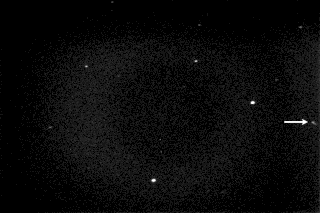
(162058) 1997 AE12 is a stony, sub-kilometer asteroid and likely the slowest rotator known to exist. It is classified as near-Earth object of the Amor group and measures approximately 800 meters in diameter. The asteroid was discovered on 10 January 1997 by the Spacewatch survey at Kitt Peak National Observatory near Tucson, Arizona

2014 JO25 is a near-Earth asteroid. It was discovered in May 2014 by astronomers at the Catalina Sky Survey near Tucson, Arizona - a project of NASA's NEO (Near Earth Object) Observations Program in collaboration with the University of Arizona.

(190166) 2005 UP156 is a stony asteroid and binary system, classified as near-Earth object of the Apollo group, approximately 1 kilometer in diameter. It was discovered on 31 October 2005, by astronomers of the Spacewatch survey at the Kitt Peak National Observatory in Arizona, United States. Its minor-planet moon with an orbital period of 40.25 hours was discovered in 2017.

(163899) 2003 SD220 is a sub-kilometer asteroid and tumbling slow rotator, classified as near-Earth object and potentially hazardous asteroid of the Aten group, which orbit the Sun between Venus and Earth. Its orbital period of 0.75 years means that it orbits the Sun about 4 times for every 3 of the Earth. It was discovered on 29 September 2003, by astronomers of the Lowell Observatory Near-Earth-Object Search at Anderson Mesa Station near Flagstaff, Arizona.

(505657) 2014 SR339, provisional designation 2014 SR339, is a dark and elongated asteroid, classified as near-Earth object and potentially hazardous asteroid of the Apollo group, approximately 970 meters (3,200 feet) in diameter. It was discovered on 30 September 2014, by NASA's Wide-field Infrared Survey Explorer telescope (WISE) in Earth's orbit. Closely observed at Goldstone and Arecibo in February 2018, it has a rotation period of 8.7 hours.
(143651) 2003 QO104, provisional designation 2003 QO104, is a stony asteroid, slow rotator and suspected tumbler on a highly eccentric orbit, classified as near-Earth object and potentially hazardous asteroid of the Amor and Apollo group, respectively. It was discovered on 31 August 2003, by astronomers of the Near-Earth Asteroid Tracking program at the Haleakala Observatory in Hawaii, United States. The Q-type asteroid has a rotation period of 114.4 hours and possibly an elongated shape. It measures approximately 2.3 kilometers (1.4 miles) in diameter and belongs the largest potentially hazardous asteroids known to exist.
(385343) 2002 LV, provisional designation 2002 LV, is a stony asteroid on a highly eccentric orbit, classified as near-Earth object and potentially hazardous asteroid of the Apollo group, approximately 1.5 kilometers in diameter. It was discovered on 1 June 2002, by astronomers with the Lincoln Near-Earth Asteroid Research at the Lincoln Laboratory's Experimental Test Site near Socorro, New Mexico, in the United States. The Sr-type asteroid has a rotation period of 6.2 hours and is likely elongated.
(154276) 2002 SY50, provisional designation 2002 SY50, is a stony asteroid on a highly eccentric orbit, classified as near-Earth object and potentially hazardous asteroid of the Apollo group, approximately 1.1 kilometers (0.7 miles) in diameter. It was discovered on 30 September 2002, by astronomers with the Lincoln Near-Earth Asteroid Research at the Lincoln Laboratory's Experimental Test Site near Socorro, New Mexico, in the United States. The K-type asteroid has a rotation period of 4.8 hours. It will make a close encounter with Earth on 30 October 2071.

2016 DV1 is a near-Earth asteroid estimated to be roughly 29–65 meters (95–210 feet) in diameter. It is a fast rotating asteroid of the Apollo group which was first observed by the Mount Lemmon Survey on 28 February 2016, just days before it passed Earth at 1 lunar distance (LD) on 3 March 2016. The elongated fast rotator has a rotation period of 303 seconds. It was recovered in February 2021 as it was about to pass Earth on 3 March 2021 at a distance of 0.0053 AU (2.1 LD; 790,000 km; 490,000 mi).











